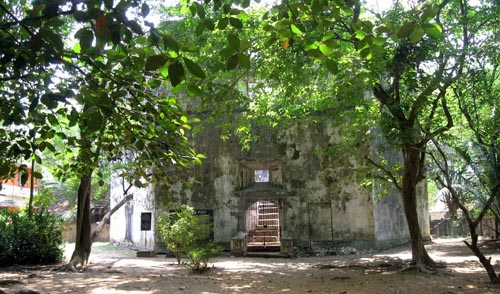Pallipuram Fort

Information on Pallipuram Fort (Kochi, Ernakulam, Kerala) - History & Architecture
Pallipuram Fort is a great Island fort in Kochi (Cochin) Ernakulam district of Kerala, built by the Portugal in the advent of 16th century AD. It is the only fort, which is in its shape till today in India. This for is a popular fort for having six side fortification, which is visited by tourist daily at Pallipuram P.O, Vyppin Taluk, Ernakulum District, Kerala State of South India.
Pallipuram Fort Architecture
Pallipuram Fort is built in hexagonal structure. The reason of such kind of fort is still not known in the Vyppin Island. It is a magnificent structure with large and thick fortification all around. The building martial's used here are the sea rock dusts, latrite stone, granite stone, lime stone, woods and mortar. On the outer side it has got a very good trench with a vast vegetation cover along the fortified wall. This is a technique to confuse enemies who is approaching the fort without the knowledge of the fort will get in to this trapped trenches. Inside the fort there are huge storage rooms. There are special storage rooms for weapons. It has got a garrison ground and settlement area. There are many open spaces left inside the fort for some purposes, which are till unknown till now. A square shaped pond is found here, which may be the origin of fresh water to serve inside the fort. There are watch towers to keep a vigil of the Arabian Sea and the surrounding land masses. The fort is well placed at the edge of this Vyppin Island. Its basement is very strong, that this fort still has not ruined with time. From the basement entry to its ground floor is at a height of 5 feet, no other fort has such distinctions. There are cannon firing places all around the fort.
Pallipuram Fort History
Pallipuram Fort was enacted in the year 1503 by the Portugal Colonialist. This port is at the edge of a Vyppin Island to take advantage of its inland waterways and the Arabian Sea. It became an important place for trade in those days. Since, it was nigh connected with backwaters, the Sea and the mainland area of Cochin. This fort also witnessed the colonial crises and internal conflicts by the local Kings of India. The Dutch's took over this fort from Portuguese and held with them until they betrayed to the Travancore prince in the year 1789 AD. This fort became the permanent assets of the Travancore kingdom until the independence of India. It is recorded in the Kerala history that the British East India Company tried to occupy this fort many time and faced defeats only. The name of the fort Pallipuram has a history, since there was a church side by the fort. The Church in Malayalam is called as Palli and Puram means place, hence the Pallipuram fort name emerged locally with time in history. This for is also known as Allikota. The expansion of Mysore kingdom in to the Malabar regions in the year 1785 AD was sought by the Mysore King Tipu Sultan. He was knee over this fort and tried to attach it. But, it is said in the history that the Manjumatha Church near by the fort, which was also built by Portugal saved this fort by forming a mist around it and concealed it from the aggression. He was an Islam by religion and trying to destroy this church and the fort went abortive.
Pallipuram Fort Tourism Importance
Pallipuram Fort is a rear Island for to see. It is a heritage monument built by the Portuguese in India, well known for its architectural aspects. It is a tourist spot in Vyppin and is open to public to see the Colonial glory of the past Travancore history.
- Andaman Nicobar Monuments
- Andhra Pradesh Monuments
- Assam Monuments
- Bihar Monuments
- Chhattisgarh Monuments
- New Delhi Monuments
- Goa Monuments
- Gujarat Monuments
- Haryana Monuments
- Himachal Pradesh Monuments
- Jammu and Kashmir Monuments
- Karnataka Monuments
- Kerala Monuments
- Madhya Pradesh Monuments
- Maharashtra Monuments
- Odisha Monuments
- Punjab Monuments
- Rajasthan Monuments
- Tamil Nadu Monuments
- Telangana Monuments
- Uttar Pradesh Monuments
- West Bengal Monuments